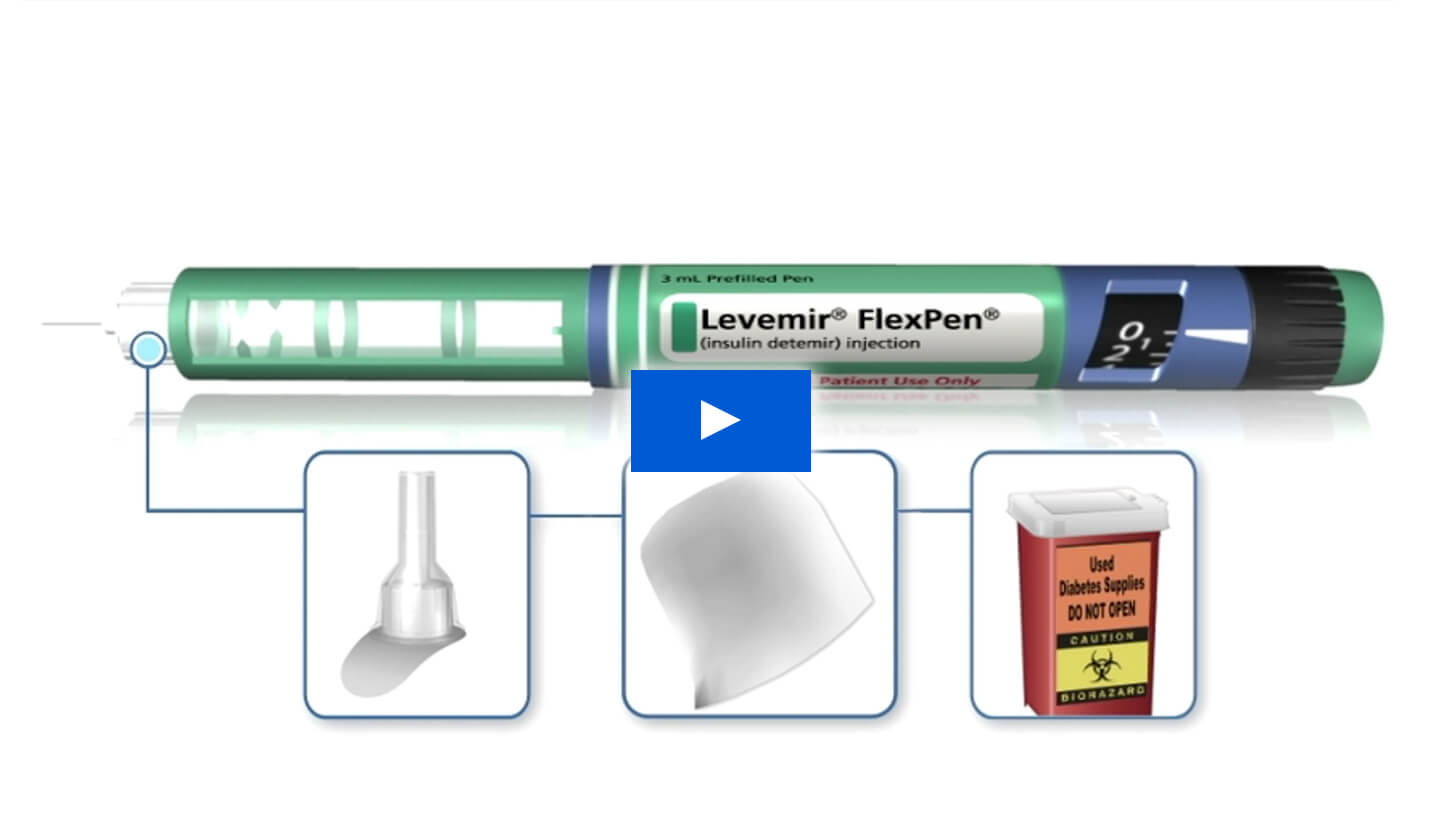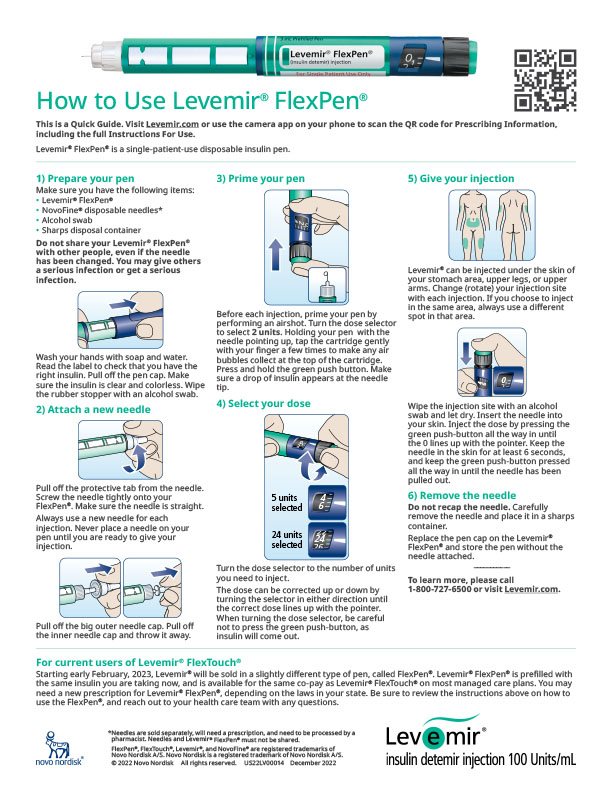Dosing and administration for Levemir® (insulin detemir) injection 100 U/mL
For adult patients on Levemir®
Starting dose: When initiating Levemir®, start insulin-naïve patients with type 2 diabetes on 10 units once-dailya dosage or 0.1 to 0.2 units/kg daily dosage with the evening meal or at bedtime and titrate accordingly.1
Physician-directed patient self-titrationb: For patients taking Levemir® once daily,a the dose can be adjusted to reach fasting plasma glucose (FPG) goals: 70-90 mg/dL or 80-110 mg/dL, as seen in the TITRATE™ study.2
Dose adjustments: Can be made every third day based on an average of 3 consecutive FPG values.2

aLevemir® can be dosed once or twice daily.1
bClinical judgment should be used for dose adjustments and to account for hypoglycemia. The dose of Levemir® should be adjusted to achieve glycemic targets.

Levemir® is available in a 10-mL vial
For patients who use conventional insulin injection techniques. Available until December 31, 2024 or while supplies last.

Administration resources for your patients using the Levemir® FlexPen® device
Indications and Usage for Levemir® (insulin detemir) injection 100 U/mL
- Levemir® (insulin detemir) injection 100 U/mL is indicated to improve glycemic control in adult and pediatric patients with diabetes mellitus.
Limitations of Use
Levemir® is not recommended for the treatment of diabetic ketoacidosis.
Important Safety Information
Contraindications
- Levemir® is contraindicated during episodes of hypoglycemia and in patients hypersensitive to insulin detemir or any of the excipients in Levemir®. Reactions have included anaphylaxis.
Warnings and Precautions
- Never Share a Levemir® FlexPen® prefilled pen, Needle, or Syringe Between Patients: Levemir® FlexPen® prefilled pens must never be shared between patients, even if the needle is changed. Patients using Levemir® vials should never share needles or syringes with another person. Sharing poses a risk for transmission of blood-borne pathogens.
- Hyperglycemia or Hypoglycemia with Changes in Insulin Regimen: Changes in an insulin regimen (e.g., insulin strength, manufacturer, type, or injection site or method of administration) may affect glycemic control and predispose to hypoglycemia or hyperglycemia. Repeated insulin injections into areas of lipodystrophy or localized cutaneous amyloidosis have been reported to result in hyperglycemia; and a sudden change in the injection site (to an unaffected area) has been reported to result in hypoglycemia. Make any changes to a patient’s insulin regimen under close medical supervision with increased frequency of blood glucose monitoring. Advise patients who have repeatedly injected into areas of lipodystrophy or localized cutaneous amyloidosis to change the injection site to unaffected areas and closely monitor for hypoglycemia. Adjustments in concomitant anti-diabetic treatment may be needed.
- Hypoglycemia: Hypoglycemia is the most common adverse reaction of insulin, including Levemir®. Severe hypoglycemia can cause seizures, may be life-threatening or cause death. Hypoglycemia can impair concentration ability and reaction time; this may place the patient and others at risk in situations where these abilities are important (e.g., driving or operating other machinery). Hypoglycemia can happen suddenly and symptoms may differ in each patient and change over time in the same patient. Symptomatic awareness of hypoglycemia may be less pronounced in patients with longstanding diabetes, in patients with diabetic neuropathy, using drugs that block the sympathetic nervous system (e.g., beta-blockers), or who experience recurrent hypoglycemia.
Risk Factors for Hypoglycemia: The risk of hypoglycemia generally increases with intensity of glycemic control. The risk of hypoglycemia after an injection is related to the duration of action of the insulin and, in general, is highest when the glucose lowering effect of the insulin is maximal. As with all insulins, the glucose lowering effect time course of Levemir® may vary among different patients or at different times in the same patient and depends on many conditions, including the area of injection as well as the injection site blood supply and temperature. Other factors which may increase the risk of hypoglycemia include changes in meal pattern, changes in level of physical activity, or changes to concomitant drugs. When a GLP-1 receptor agonist is used in combination with Levemir®, the Levemir® dose may need to be lowered or more conservatively titrated to minimize the risk of hypoglycemia. Patients with renal or hepatic impairment may be at higher risk of hypoglycemia. Patients and caregivers must be educated to recognize and manage hypoglycemia. In patients at higher risk for hypoglycemia and patients who have reduced symptomatic awareness of hypoglycemia, increased frequency of blood glucose monitoring is recommended. - Hypoglycemia Due to Medication Errors: Accidental mix-ups between insulin products have been reported. To avoid medication errors between Levemir® and other insulins, instruct patients to always check the insulin label before each injection.
- Hypersensitivity and Allergic Reactions: Severe, life-threatening, generalized allergy, including anaphylaxis, can occur with insulin, including Levemir®. If hypersensitivity reactions occur, discontinue Levemir®; treat per standard of care and monitor until symptoms and signs resolve.
- Hypokalemia: All insulins, including Levemir®, cause a shift in potassium from the extracellular to intracellular space, possibly leading to hypokalemia. Untreated hypokalemia may cause respiratory paralysis, ventricular arrhythmia, and death. Monitor potassium levels in patients at risk for hypokalemia if indicated (e.g., patients using potassium-lowering medications, patients taking medications sensitive to serum potassium concentrations).
- Fluid Retention and Heart Failure with Concomitant Use of PPAR-gamma Agonists: Thiazolidinediones (TZDs), which are peroxisome proliferator-activated receptor (PPAR)-gamma agonists, can cause dose-related fluid retention, particularly when used in combination with insulin. Fluid retention may lead to or exacerbate heart failure. Patients treated with insulin, including Levemir®, and a PPAR-gamma agonist should be observed for signs and symptoms of heart failure. If heart failure develops, it should be managed according to current standards of care, and discontinuation or dose reduction of the PPAR-gamma agonist must be considered.
Adverse Reactions
- Adverse reactions associated with Levemir® include hypoglycemia, allergic reactions, injection site reactions, lipodystrophy, rash, and pruritus.
Drug Interactions
- There are certain drugs that may cause clinically significant drug interactions with Levemir®.
- Drugs that may increase the risk of hypoglycemia: antidiabetic agents, ACE inhibitors, angiotensin II receptor blocking agents, disopyramide, fibrates, fluoxetine, monoamine oxidase inhibitors, pentoxifylline, pramlintide, salicylates, somatostatin analog (e.g., octreotide), sulfonamide antibiotics, GLP-1 receptor agonists, DPP-4 inhibitors, and SGLT-2 inhibitors
- Drugs that may decrease the blood glucose lowering effect: atypical antipsychotics (e.g., olanzapine and clozapine), corticosteroids, danazol, diuretics, estrogens, glucagon, isoniazid, niacin, oral contraceptives, phenothiazines, progestogens (e.g., in oral contraceptives), protease inhibitors, somatropin, sympathomimetic agents (e.g., albuterol, epinephrine, terbutaline), and thyroid hormones
- Drugs that may increase or decrease the blood glucose lowering effect: alcohol, beta-blockers, clonidine, lithium salts, and pentamidine
- Drugs that may blunt the signs and symptoms of hypoglycemia: beta-blockers, clonidine, guanethidine, and reserpine
Use in Specific Populations
- Pregnancy: Available data from published studies and postmarketing case reports with Levemir® use in pregnant women have not identified a drug-associated risk of major birth defects, miscarriage, or adverse maternal or fetal outcomes.
- Clinical Considerations - Disease-Associated Maternal and/or Embryo/Fetal Risk: Poorly controlled diabetes in pregnancy increases the maternal risk for diabetic ketoacidosis, preeclampsia, spontaneous abortions, preterm delivery, and delivery complications. Poorly controlled diabetes increases the fetal risk for major birth defects, stillbirth, and macrosomia-related morbidity.
- Clinical Considerations - Disease-Associated Maternal and/or Embryo/Fetal Risk: Poorly controlled diabetes in pregnancy increases the maternal risk for diabetic ketoacidosis, preeclampsia, spontaneous abortions, preterm delivery, and delivery complications. Poorly controlled diabetes increases the fetal risk for major birth defects, stillbirth, and macrosomia-related morbidity.
Please click here for Levemir® Prescribing Information.
References:
- Levemir. Package insert. Novo Nordisk Inc; 2022.
- Blonde L, Merilainen M, Karwe V, Raskin P; TITRATE™ Study Group. Patient-directed titration for achieving glycaemic goals using a once-daily basal insulin analogue: an assessment of two different fasting plasma glucose targets—the TITRATE™ study. Diabetes Obes Metab. 2009;11(6):623-631.

